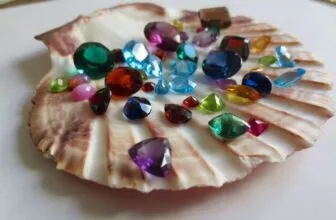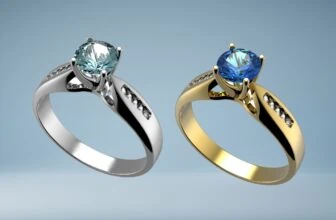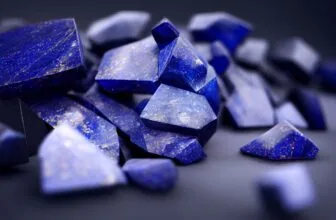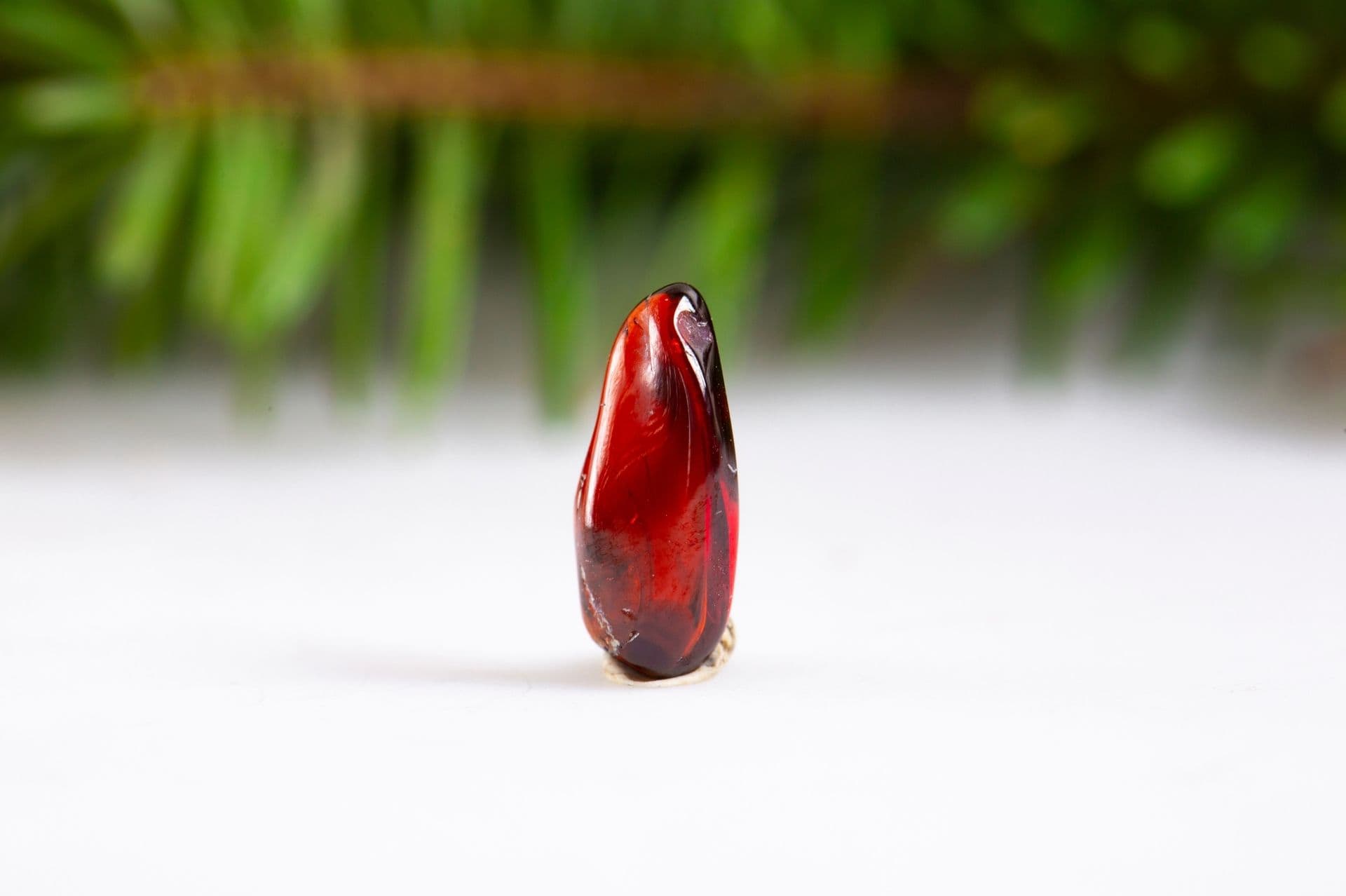
Table of Contents
Rhodolite is a gorgeous, budget-friendly gemstone that many people love for its stunning look. It often gets mistaken for other red gemstones that are much more expensive. It’s a favorite for those who want the look of a costly gemstone without the high price.
If you’re thinking about adding a rhodolite gemstone or jewelry piece to your collection, this article has everything you need to know. Let’s explore the origins of this beautiful gemstone and some unique rhodolite jewelry designs for you to consider.
What is Rhodolite?
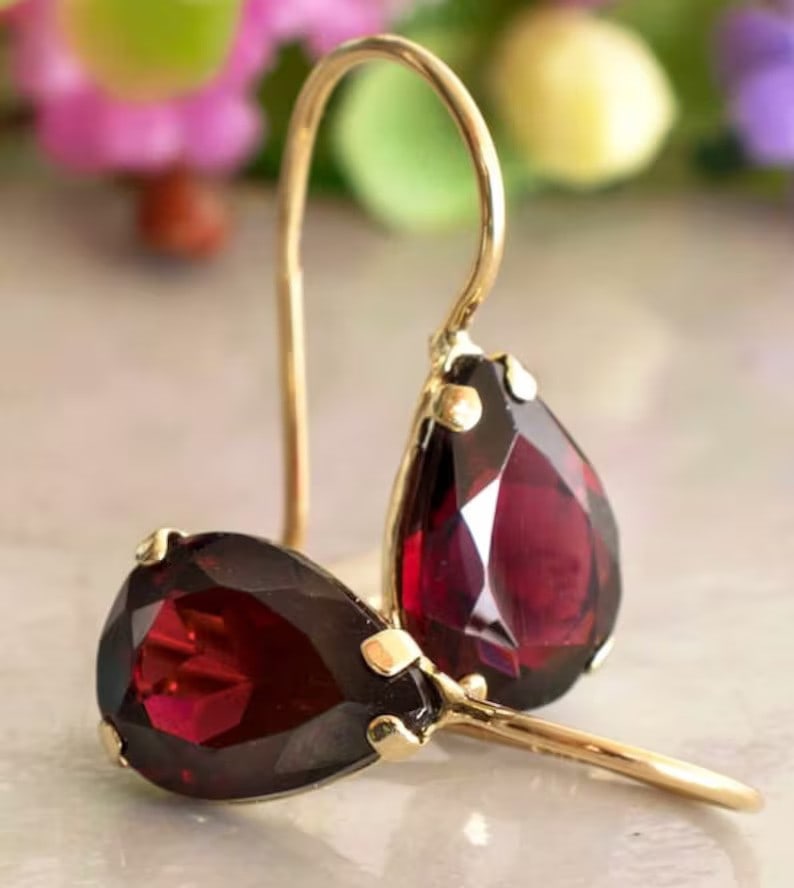
Rhodolite is a unique variety of garnet, known for its distinct reddish-purple or raspberry color. It is a blend of pyrope and almandine garnet species and stands out due to its vibrant, yet not overly dark hue, which sets it apart from other traditional garnet varieties that are usually deeper red.
This gemstone is appreciated for its transparency, refractive qualities, and durability, making it well-suited for various types of jewelry. Their relative abundance and appealing color make them a popular choice for those seeking a striking yet affordable gemstone.
Origin and History of Rhodolite
Rhodolite was first discovered in 1890 by mineralogist William Hidden in North Carolina, U.S.A. Since its discovery in the Cowee Valley, rhodolite has appeared in many places worldwide, including Norway, Mozambique, Kenya, Greenland, and other U.S. states. Today, major sources of rhodolite are Tanzania, India, Zimbabwe, and Sri Lanka, giving it a global presence.
The name ‘rhodolite’ comes from the Greek word ‘rhodon’, meaning ‘rose’, inspired by the pinkish-red rhododendron flower native to North Carolina. This name reflects its rosy color, varying from soft pink to deep purple/violet red. This range of colors has made rhodolite very popular in the jewelry industry.
Rhodolite’s appeal in jewelry also comes from its affordability. It’s an attractive alternative to more expensive gemstones with a similar look, providing the luxury of a precious stone at a lower cost. Rhodolite has become a staple in various jewelry types, including rings, necklaces, earrings, and bracelets. It appeals to many tastes and remains a valued and sought-after gemstone.
The 4 C’s of Rhodolite
When evaluating the quality of a rhodolite gemstone, it’s important to take the following quality factors into consideration: the color, cut, carat and clarity of the stone. Let’s look into each of these in more detail.
1. Rhodolite Color

Rhodolite garnet’s unique raspberry to purple-red color comes from its mix of pyrope and almandine garnet. This mix makes rhodolite different from other garnets, giving it a brighter and lighter shade. Iron and magnesium in its structure mainly determine rhodolite’s color.
Iron deepens the red, while magnesium lightens it, creating the typical raspberry or purple-red color. Rhodolite’s color is natural, usually not treated or enhanced. This natural color results from the specific conditions where rhodolite forms, making each stone’s color reflect its unique mineral and geographic origins.
The iron and magnesium balance, combined with how it forms, produces rhodolite garnet’s range of colors, from soft pinks to deep purples.
2. Rhodolite Cut
Because of its durability, rhodolite is an easy to stone to cut into different shapes and sizes. Some of the most common shapes include ovals, trillions, emeralds and cushions but these are just a few of many. Cabochon-cut rhodolite is fairly common and the stone is also faceted in order to enhance its shine and brilliance.
When cutting rhodolite, jewelers try to retain as much of the stone’s weight as possible from the rough, to avoid wastage. Due to this reason, you may come across rhodolite cut in unique shapes that are quite different from the common cuts.
3. Rhodolite Clarity
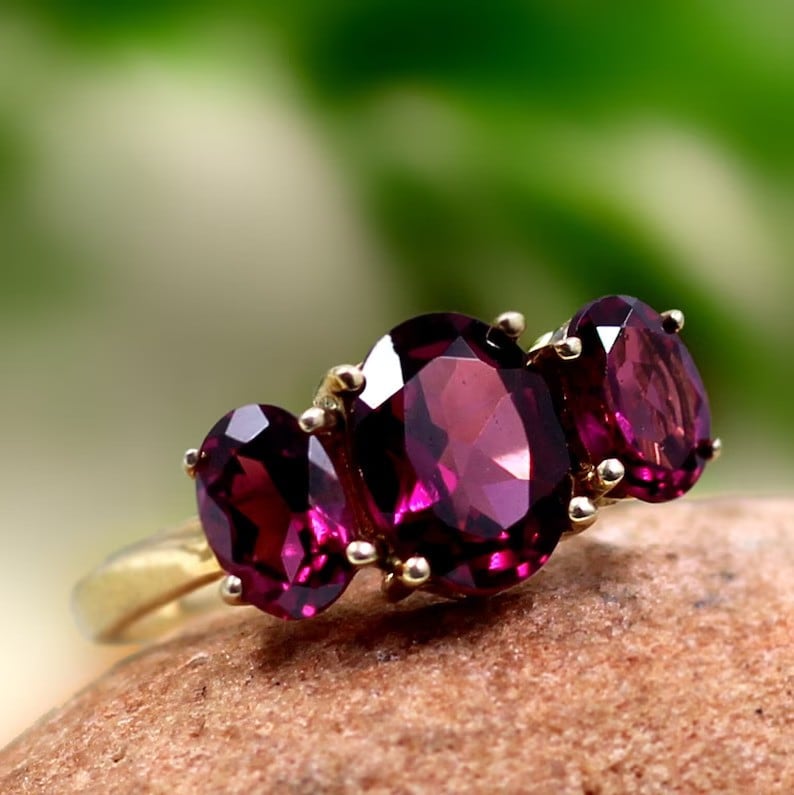
One of the most important quality factors to consider when evaluating rhodolite is the clarity of the stone. In gemology, clarity refers to the imperfections (or inclusions) in a stone, which can reduce its overall value. The more inclusions it has, the more its value will decrease.
High quality rhodolite gemstones don’t usually have any inclusions visible to the naked eye, but they may have tiny inclusions inside the stone. They’re also more brilliant and lustrous in comparison to the lower quality stones.
4. Rhodolite Carat Size
Rhodolite garnet stands out for its beautiful color and is available in many carat sizes, meeting different jewelry needs. You often find rhodolite in small to medium sizes, typically from less than one carat to around five carats. These sizes fit well in various jewelry pieces like rings, earrings, and pendants, providing a noticeable yet balanced splash of color.
Larger rhodolite stones, over five carats, are more rare and thus highly prized by collectors and jewelry enthusiasts. The value of rhodolite usually goes up with size, especially when the larger stones also have clear, bright colors.
However, this price increase is not as high as in some other gemstones, making big rhodolite garnets a more affordable option for those who want eye-catching pieces without a huge cost. This range in carat size offers options for both understated and bold jewelry designs, making rhodolite a versatile choice for different fashion tastes.
Is Rhodolite Treated or Enhanced?
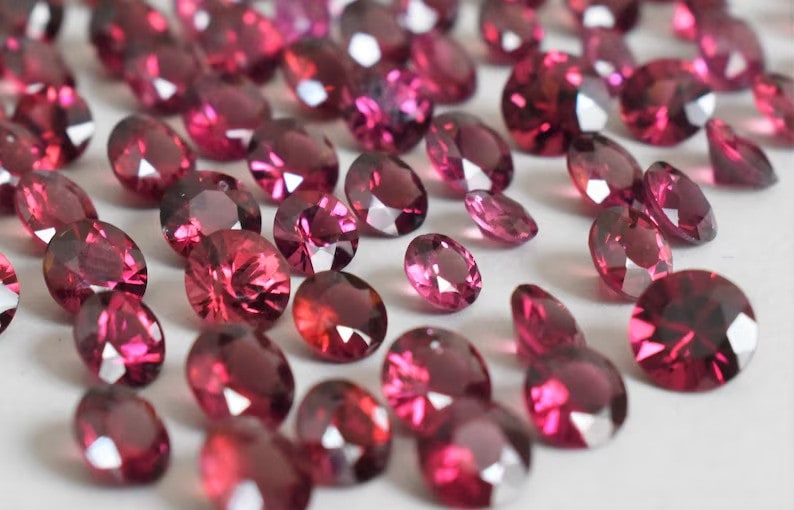
Rhodolite garnet is famous for its natural, captivating colors and usually doesn’t go through any treatment or enhancement. This is a big part of its charm. While many gemstones need treatments to improve their color or clarity, rhodolite is prized for its natural beauty straight from the ground.
Its color range, from raspberry to rose-red and purple, is stable and doesn’t require any artificial boosting. This makes rhodolite a top choice for gem lovers who prefer natural stones and assures buyers of its natural origin. However, buyers should always ask about any treatments when buying rhodolite. Treated stones are rare but can still be found in the market.
Reputable jewelers and gem sellers usually tell you if a stone has been treated, keeping the buying process transparent. The fact that rhodolite doesn’t need enhancing makes it more affordable, appealing to those who want natural beauty without the extra cost of enhanced gems.
Rhodolite vs. Other Red Gemstones
Rhodolite is often confused with other red gemstones that are far more expensive (like the ruby or tourmalines). However, the difference can be easily noticed when looking at the base of the stones’ color.
Stones like pink tourmaline and rubellite exhibit vivid, saturated pink and red tones regardless of how dark or light their shade may be. Rhodolites, on the other hand, have a duskier or more blush pink base tone.
Some stones, such as red and pink tourmalines usually exhibit pleochroism which can be easily seen, but this isn’t common in rhodolites. Pleochroic gems usually show two or more colors when they’re viewed from various angles, something that’s never seen in rhodolite gemstones. Rhodolite, on the other hand, has rutile silk within it that’s not seen in tourmalines.
Rhodolite Jewelry Designs
Rhodolite is a highly popular gemstone for jewelry because of its gorgeous appearance and durability. There are various types of attractive rhodolite jewelry designs available on the market, from minimal to extravagant. Let’s take a look at some of these designs.
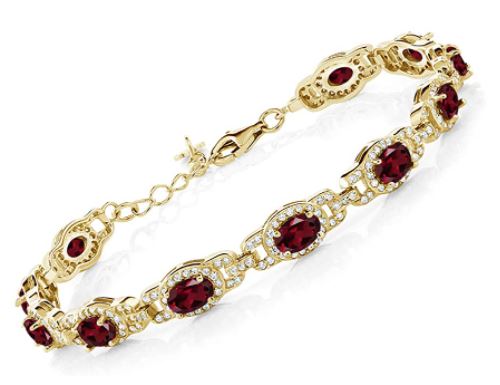
A highly versatile gemstone, rhodolite makes for all kinds of stunning jewelry, including bracelets, pendants, necklaces, rings and earrings. Because of the gemstone’s lovely, reddish color, it looks best with metallic or white metals. Together, the colors give the piece a chic, modern look.
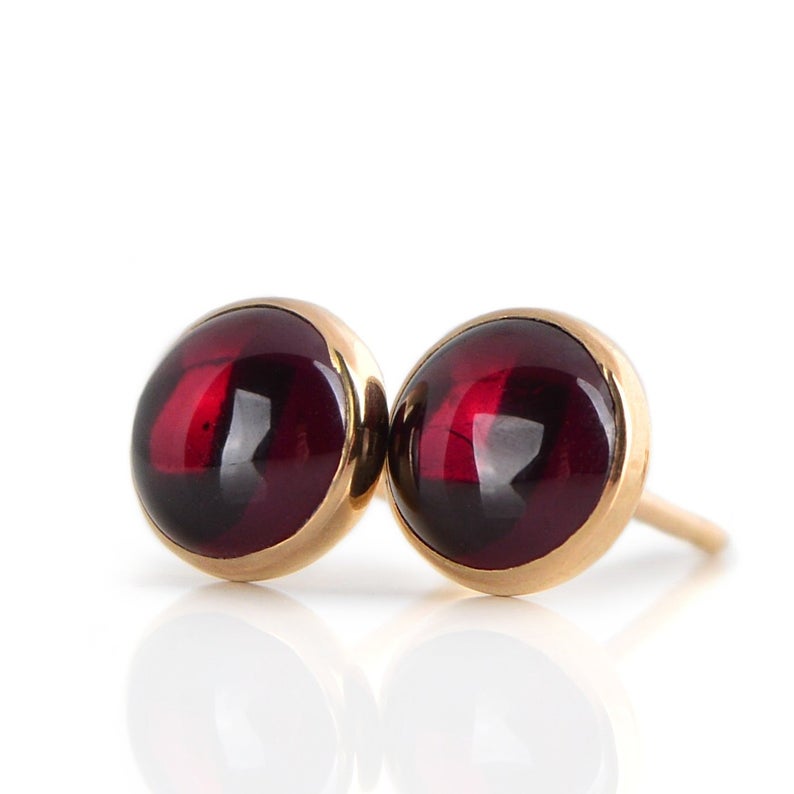
If you’re looking for a classic, vintage piece, a simple pair of rhodolite stones set in rose or yellow gold would be a perfect choice. You can find them in various cuts and styles including cabochons, emerald cut and faceted stones or you can even opt for a pair with natural rough rhodolite which would look quite unique.
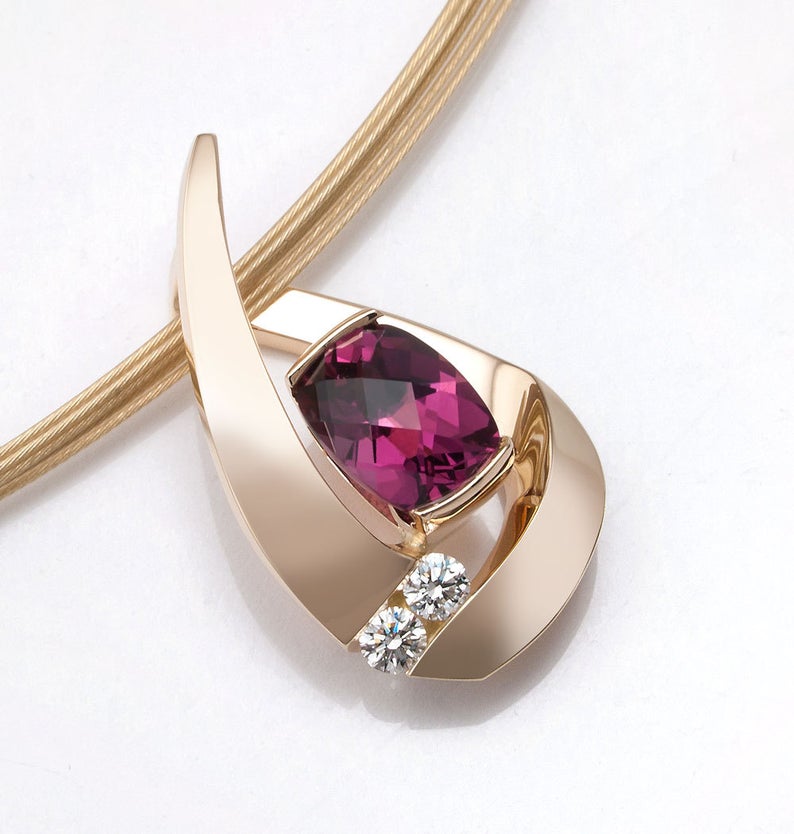
If you’re more into eye-catching, unique jewelry pieces that look classy and elegant, you can always opt for a beautiful rhodolite pendant like this one. However, if you’re looking for something more minimalist, you can choose a simple necklace and pendant instead without too many embellishments.
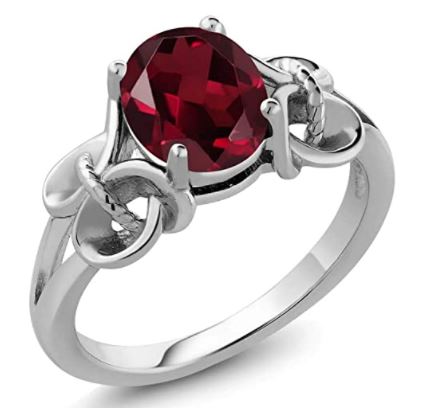
Over the years, rhodolite has become quite popular for engagement rings, mainly because of its durability. While it’s a lot harder than most other gemstones, it does need a little more care and maintenance than stones like rubies or diamonds, which are common choices for engagement rings.
However, if you’re committed to taking care of your rhodolite engagement ring and if you select a protective setting for it, like a halo or bezel setting, then this gemstone can be an excellent choice.
What are the Uses and Symbolism of Rhodolite?
Rhodolite (also called the stone of inspiration), is believed to bring inspiration of love to its wearer through the heart and mind. It encourages kindness, love and compassion and is also said to promote the wearer’s spiritual growth and self-worth.
A popular stone used in crystal healing, rhodolite is also said to be useful in the treatment of certain disorders of the lungs and heart, while also stimulating metabolism. Many crystal healers use this gemstone for these purposes as well as to relieve blood disorders and boost blood circulation.
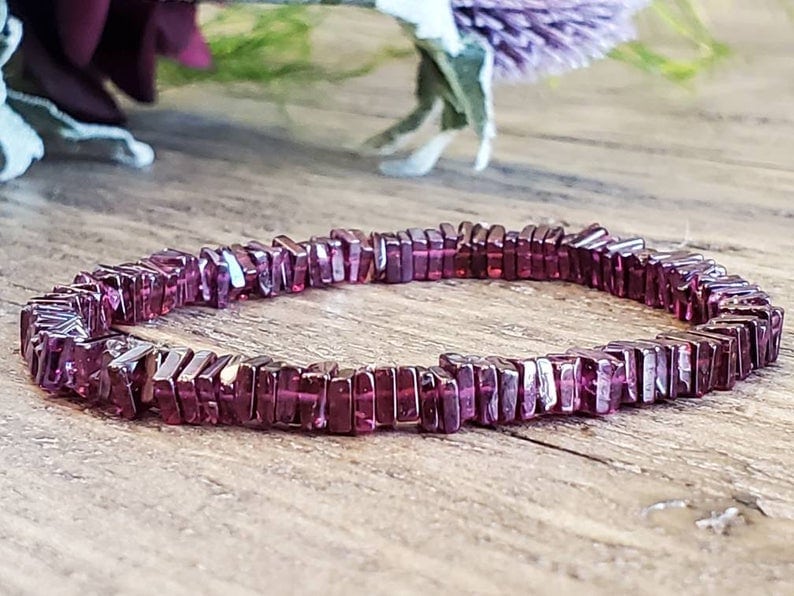
Some people believe that rhodolite has the power to make its wearer smarter by organizing the information in their mind, clearing the mind and making it easier to focus. It’s believed to attract happiness into the wearer’s life and is also used to purify and re-energize the wearer’s chakras.
Centuries ago, rhodolite gemstones were worn as protective talismans that were believed to protect the wearer from harm and injury. Even today, many people around the world regard it as a protective stone and wear it as amulets or talismans to keep themselves safe.
Rhodolite Care and Maintenance
Rhodolite has a hardness of 7 – 7.5 on Mohs hardness scale which means that it’s fairly durable and with a little extra care and maintenance, it’s likely to last for a lifetime. Here are some tips on how to take care of your rhodolite gemstone or jewelry:
- Use only warm, soapy water to clean the stone. This should be enough to keep the stone sufficiently clean. However, if you notice dirt clogged in the jewelry setting, you can use a soft brush to scrub gently. Never scrub the stone vigorously or you’ll risk scratching it.
- Store away from hard objects. Keep your rhodolite piece away from hard objects that can knock and damage it. It’s also important to keep it away from any softer stones in your jewelry collection since it can scratch them. You can wrap it up in a soft cloth or place it in a jewelry box to keep it safe.
- Avoid using heat. As we’ve mentioned above, rhodolite doesn’t do well in heat since it changes color. Therefore, avoid using heat to clean it.
- Don’t use harsh chemicals on your piece. Chemicals found in detergents, cosmetics, lotions and perfumes are too harsh for jewelry and can ruin the appearance of your gemstone.
- Avoid placing the stone in mechanical cleaners. Never use mechanical cleaning systems to clean your rhodolite piece. Even if your piece shows no visible inclusions, it may have smaller inclusions inside it that can burst due to extreme temperatures or ultrasound and the result will be a fractured stone.
- Take off your rhodolite piece before engaging in physical activities. If you’re someone who uses your hands a lot, you might want to remove any rhodolite rings first to prevent the piece from getting scratched.
Where to Buy Rhodolite Jewelry?
If you’re interested in buying your rhodolite jewelry online, we recommend the following online platforms:
- Brian Gavin stands out for their meticulous craftsmanship and attention to detail in rhodolite jewelry, featuring exquisite designs and high-quality settings. They also offer extensive customization services, allowing customers to create personalized pieces, perfect for those seeking unique designs.
- Etsy’s marketplace is a hub for unique and handcrafted rhodolite jewelry, offering a wide selection from independent artists and jewelers. Shopping here supports small businesses and individual craftspeople, adding a meaningful touch to the purchase.
- Angora Jewelers is synonymous with luxury and elegance, known for their exclusive and sophisticated rhodolite jewelry collections. They bring expertise in fine jewelry, offering expert advice and a premium shopping experience for those seeking high-end quality and style.
- Blue Nile, as an online retailer, boasts a vast selection of rhodolite jewelry, catering to various styles and preferences. They make shopping convenient, providing detailed product information, high-quality images, and educational resources online.
Rhodolite FAQs
Let’s take a quick look at some of the most frequently asked questions about rhodolite gemstones:
1. Where does rhodolite come from?
First discovered in North Carolina, U.S.A, Rhodolite is now found in several other countries including India, Sri Lanka, Tanzania, Madagascar, Brazil and Zimbabwe.
2. Is rhodolite rare?
While rhodolite gemstones are found in abundance in many countries, fine quality rhodolite with medium tone and medium-high saturation are very rare and highly priced. These rare stones have a strong pinkish-red color which is called ‘spirit color’ by miners since it looks similar to gasoline.
3. Is rhodolite gemstone expensive?
Rhodolite is much less expensive than the rest of the rare garnets and high quality stones can be found for about $150 to $350 per carat.
4. How can I tell the difference between fake and real rhodolite?
The easiest way to identify a fake rhodolite is by looking at its color. Genuine rhodolite gemstones have a lovely, pinkish-raspberry color that’s unique and not seen in other pink or red gemstones. If you’re unable to tell the difference from the color, you can check to see if the stone is magnetic. Rhodolite has a high manganese and iron content, meaning that it’s magnetic, so you can use a neodymium magnet to check if it’s genuine or fake. If the stone sticks to the magnet, it’s a genuine rhodolite.
5. Is rhodolite valuable?
Spirit colored rhodolite is extremely valuable due to its rarity and high quality. Gemstones that exhibit more pink and purple are considered to be more valuable. A 10-carat bright purple rhodolite can cost up to $2000 per carat, since stones of this color are the most expensive.
6. Is rhodolite a durable gemstone?
Rhodolite ranks at 7-7.5 on Mohs’ scale of hardness which means that it’s a durable gemstone and can be used for various types of jewelry.
Wrapping Up
Valued and used by various cultures for its mystical properties and stunning appearance, rhodolite is a beautiful gemstone that would make a great addition to any jewelry collection. A simple piece of rhodolite jewelry is an excellent way to spice up even the simplest of outfits and the best part is, it won’t burn a hole in your wallet.


